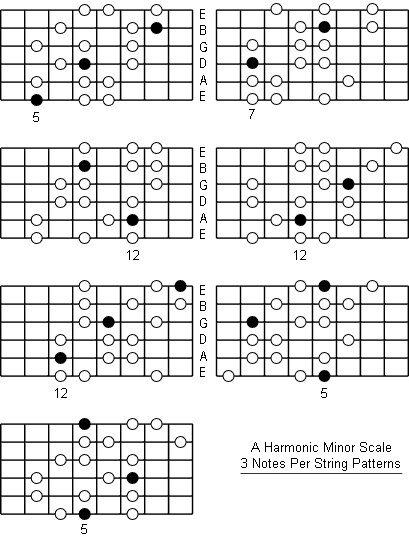So do these modal scales have forms like Saiyans do or what?
In this tutorial, we are going to look at how harmonic minor scales modes are built. So, let's have some fun.
2. Harmonic minor scale modes explained
Much like how each major scale has its modal scales, each minor scale can also have different modes. And while the ones for the natural minor scale are the same ones as the ones for its relative major scale, just in a different order, when it comes to harmonic minor scales and melodic minor scales, things are a bit different. The modes have different formulas and consequently will have different names.
What is the same though is the number of modes a harmonic minor scale can have, which is 7. The first one is basically the harmonic minor scale itself. And the formula which is based on the major scale is the following:
Similar to how we built modal scales in the previous tutorial, what this translates to is the major scale, but with a flatted third and sixth notes. For example, the C major scale is C D E F G A B while the C minor harmonic scale is C D E♭ F G A♭ B.
The next mode is called the Locrian 13 or Locrian 6 and has the following formula:
The fourth harmonic modal scale is the Dorian ♯11 (or Dorian ♯4), which is basically a Dorian scale, but with a sharpened 4th note:
The penultimate one is the Lydian ♯2, which is basically a Lydian scale, but with a sharpened 2nd note:
And I know what you're thinking. Easy enough, just a bunch of flats and sharps here and there. Therefore, I give you the final one, which is called the Super Locrian ♭♭7:
The funny thing about these modes is that I never really used them all that much, but it seems that they offer quite the possibility in terms of cool sounds. Some examples of how they can be used include but are not limited to:
- Topics of discussion
- Harmonic minor scale modes explained
In this tutorial, we are going to look at how harmonic minor scales modes are built. So, let's have some fun.
2. Harmonic minor scale modes explained
Much like how each major scale has its modal scales, each minor scale can also have different modes. And while the ones for the natural minor scale are the same ones as the ones for its relative major scale, just in a different order, when it comes to harmonic minor scales and melodic minor scales, things are a bit different. The modes have different formulas and consequently will have different names.
What is the same though is the number of modes a harmonic minor scale can have, which is 7. The first one is basically the harmonic minor scale itself. And the formula which is based on the major scale is the following:
1 2 ♭3 4 5 ♭6 7
Similar to how we built modal scales in the previous tutorial, what this translates to is the major scale, but with a flatted third and sixth notes. For example, the C major scale is C D E F G A B while the C minor harmonic scale is C D E♭ F G A♭ B.
The next mode is called the Locrian 13 or Locrian 6 and has the following formula:
1 ♭2 ♭3 4 ♭5 6 ♭7
Next in line is the Ionian ♯5, which has a much simpler formula:
1 2 3 4 ♯5 6 7
The fourth harmonic modal scale is the Dorian ♯11 (or Dorian ♯4), which is basically a Dorian scale, but with a sharpened 4th note:
1 2 ♭3 ♯4 5 6 ♭7
Next in line is the Phrygian dominant:
1 ♭2 3 4 5 ♭6 ♭7
The penultimate one is the Lydian ♯2, which is basically a Lydian scale, but with a sharpened 2nd note:
1 ♯2 3 ♯4 5 6 7
And I know what you're thinking. Easy enough, just a bunch of flats and sharps here and there. Therefore, I give you the final one, which is called the Super Locrian ♭♭7:
1 ♭2 ♭3 ♭4 ♭5 ♭6 ♭♭7
And yeah, that's actually a double flatted note at the end there.
The funny thing about these modes is that I never really used them all that much, but it seems that they offer quite the possibility in terms of cool sounds. Some examples of how they can be used include but are not limited to:
- harmonic minor scale - can be played over minMaj7 chords, or chords like m6, m7, m9, m11, m6/9
- Locrian 6 - anywhere you play the Locrian mode, generally over half-diminished chords
- Ionian ♯5 - usually played over maj7♯5 chords
- Dorian ♯11 - can be used as an alternative to the Dorian scale and is usually played over minor chords
- Phrygian dominant - you can play it for dominant chords to add a bit of Jazz vibe to your songs
- Lydian ♯2 - usually played over major 7th chords and can act as a substitute to the Lydian scale
- Super Locrian ♭♭7 - a rarely used scale, but it can be used to great over diminished 7th chords
Last edited:



